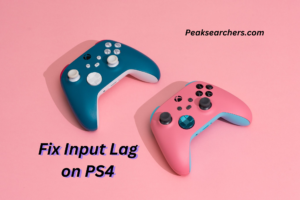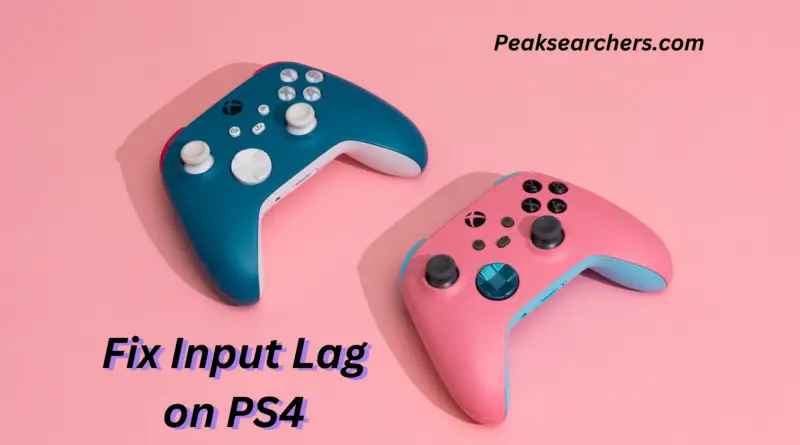How to Fix Input Lag on PS4? A DIY Solution
Welcome to our comprehensive guide on how to fix input lag on your PS4 gaming console. If you’re experiencing frustrating delays between your controller inputs and the corresponding actions on the screen, you’ve come to the right place. In this article, we will provide you with effective solutions to help you overcome input lag and enhance your gaming experience on the PlayStation 4.

Understanding Input Lag
Before we delve into the solutions, let’s take a moment to understand what input lag is and why it occurs. Input lag refers to the delay between pressing a button on your controller and seeing the corresponding action on your TV screen. This delay can significantly impact your gaming performance, making it crucial to address the issue promptly.
Solution 1: Check Your TV Settings
One of the common causes of input lag is incorrect TV settings. To optimize your gaming experience, follow these steps:
- Enable Game Mode: Most modern TVs offer a Game Mode option, which reduces input lag by disabling certain image processing features. Access your TV settings and enable Game Mode to minimize input lag.
- Disable Motion Smoothing: Motion smoothing or interpolation can introduce additional latency. Make sure to turn off this feature to reduce input lag.
Solution 2: Use a Wired Controller
Using a wireless controller may introduce slight input delays due to the nature of wireless communication. To minimize this lag, consider using a wired controller instead. Wired controllers provide a direct and faster connection, resulting in reduced input lag.
Solution 3: Reduce Network Interference
Network interference can also contribute to input lag, especially when playing online multiplayer games. To mitigate this issue, follow these steps:
- Use a Wired Internet Connection: Whenever possible, connect your PS4 directly to your router using an Ethernet cable. This ensures a stable and reliable connection, minimizing potential network-related input lag.
- Avoid Network Congestion: Limit the number of devices connected to your network while gaming. Bandwidth-intensive activities, such as streaming or downloading, can create network congestion and increase input lag.
Solution 4: Update System Software and Games
Outdated system software or game versions may contain bugs that contribute to input lag. To ensure optimal performance, make sure to update your PS4’s system software and game titles regularly. Follow these steps:
- Update System Software: Access the System Software Update option in the Settings menu of your PS4. If an update is available, download and install it to benefit from performance improvements and bug fixes.
- Update Game Titles: Check for updates within each game you play. Developers often release patches to address known issues, including input lag. By keeping your games up to date, you can minimize the chances of input lag occurring.
Solution 5: Perform a Database Rebuild
If you’ve tried the previous solutions and are still experiencing input lag, performing a database rebuild on your PS4 might help. Here’s how you can do it:
- Power off your PS4 completely.
- Press and hold the power button until you hear two beeps: the first when you initially press it and the second approximately seven seconds later.
- Connect your controller to the PS4 using a USB cable.
- Select the “Rebuild Database” option from the Safe Mode menu.
- Follow the on-screen instructions to complete the process.
Performing a database rebuild can help resolve any corrupted data or system inconsistencies that may contribute to input lag.
Understanding the Impact of Input Lag
Input lag can have a significant impact on your gaming experience. When playing fast-paced games or engaging in competitive multiplayer matches, even the slightest delay between your actions and the corresponding on-screen response can be frustrating and put you at a disadvantage. By Fix Input Lag on PS4, you can improve your reaction time, accuracy, and overall gaming performance.
Optimizing TV Settings for Gaming
In addition to enabling Game Mode and disabling motion smoothing, there are a few more TV settings you can adjust to minimize input lag:
- Response Time: Some TVs offer response time settings that can affect input lag. Look for a “Game” or “Fast” mode, which typically reduces the response time to the fastest setting available.
- Resolution and Refresh Rate: Set your PS4’s resolution to match your TV’s native resolution. Additionally, ensure that both your TV and the game you’re playing support the same refresh rate (e.g., 60Hz or 120Hz) for smoother gameplay.
Wired vs. Wireless Controllers
While wireless controllers offer convenience and freedom of movement, they introduce a slight delay due to the wireless connection. If input lag is a significant concern for you, consider switching to a wired controller. Wired controllers provide a direct connection to the console, resulting in faster response times and reduced input lag.
Internet Connection and Network Interference
For online gaming, a stable internet connection is essential. Here are a few tips to minimize network-related input lag:
- Quality of Service (QoS): If your router supports QoS settings, prioritize your gaming traffic to ensure a smoother online experience.
- Close Background Applications: Close any unnecessary applications or downloads running in the background on your PS4 or other devices connected to your network. This helps allocate more bandwidth to your gaming session and reduces potential network congestion.
Importance of Regular Updates
Keeping your PS4’s system software and game titles updated is crucial for optimal performance. Developers frequently release updates that include bug fixes, performance enhancements, and input lag optimizations. By staying up to date, you can benefit from these improvements and ensure the best possible gaming experience.
Database Rebuild
Performing a database rebuild is a troubleshooting step that can address various issues, including input lag. This process rebuilds the database of your PS4, resolving any corrupted data or inconsistencies that may be impacting performance. It’s recommended to perform this procedure if you’ve exhausted other solutions and are still experiencing input lag.
By applying these additional details and implementing the suggested solutions, you’ll have a comprehensive understanding of how to fix input lag on your PS4 and enjoy a more responsive and immersive gaming experience.
Also Read: How to Fix the Charging Port on a PS4 Controller? A Comprehensive Guide
FAQ’s
How do I reduce input lag?
To reduce input lag:
- Enable Game Mode on your TV.
- Adjust TV settings to disable motion smoothing and image enhancement.
- Use wired connections for both your internet and controller.
- Keep your system software and games updated.
- Minimize network congestion by prioritizing gaming traffic and limiting bandwidth-intensive activities.
- Consider using a gaming monitor with low input lag.
- Ensure your controller is charged and properly connected.
- Close unnecessary background applications on your console.
Implementing these steps will help minimize input lag and improve your gaming experience.
Why is the ps4 so laggy?
- Internet Connection: If you’re playing online games or streaming content, a slow or unstable internet connection can contribute to lag. Ensure you have a stable and high-speed internet connection for smooth gameplay.
- Server Issues: Lag can occur if the game servers you’re connecting to are experiencing high traffic or technical difficulties. This is beyond your control and may require patience until the server issues are resolved.
- System Overload: Running multiple applications or having limited available system resources can cause the PS4 to lag. Closing unused applications and freeing up system resources can help alleviate this issue.
- Hardware Limitations: Older PS4 models or those with insufficient processing power may struggle to handle graphically demanding games, resulting in lag. Upgrading to a more powerful console or optimizing game settings can help mitigate this.
- Heat and Ventilation: Overheating can impact the performance of your PS4 and lead to lag. Ensure your console is adequately ventilated, and consider cleaning the vents and fans to prevent overheating.
- Game Optimization: Some games may have performance issues or bugs that cause lag. Developers often release patches and updates to address these issues. Keeping your games updated to the latest version can help resolve performance-related lag.
- Controller Connection: Connectivity issues between the controller and the console can lead to input lag. Ensure your controller is properly connected and charged, or consider using a wired connection for reduced lag.
How to make PS4 faster?
- Clear up storage by removing unnecessary games and files.
- Rebuild the database in Safe Mode.
- Close background applications.
- Keep the system software updated.
- Manage and limit notifications.
- Use a wired connection for online gaming.
- Optimize game settings for performance.
- Ensure proper ventilation.
- Rebuild licenses if experiencing issues.
Following these steps will help improve the speed and performance of your PS4.
How to fix input lag on ps4 Xbox series x?
To fix input lag on your PS4 or Xbox Series X, follow these steps:
- Enable Game Mode: Both PS4 and Xbox Series X have Game Mode options. Enable this mode on your TV to reduce input lag by disabling unnecessary image processing.
- Check TV Settings: Fine-tune your TV settings for gaming. Disable features like motion smoothing or image enhancement that can introduce additional latency.
- Use a Wired Connection: For the best performance, use a wired internet connection instead of Wi-Fi. Similarly, consider using a wired controller for a more direct and responsive connection.
- Update System Software: Keep your console’s system software up to date. Developers release updates that often include performance optimizations and input lag fixes.
- Optimize Game Settings: Within games, adjust settings for optimal performance. Lower graphics settings, disable unnecessary visual effects or reduce the display resolution if needed.
- Manage Background Applications: Close any background applications or downloads on your console. This frees up system resources and reduces potential input lag.
- Reduce Network Congestion: Minimize network congestion by prioritizing gaming traffic through Quality of Service (QoS) settings on your router. Limit bandwidth-intensive activities on other devices connected to your network.
- Consider a Gaming Monitor: If input lag is a significant concern, consider using a gaming monitor with a low response time and high refresh rate. Gaming monitors are designed to minimize input lag compared to regular TVs.
- Controller and Firmware Updates: Keep your controllers up to date by installing any available firmware updates. These updates often address performance issues and can improve responsiveness.
By following these steps, you can effectively reduce input lag on your PS4 or Xbox Series X, enhancing your gaming experience with more responsive controls.
Also Read: How to Fix Stick Drift on PS4 Without Opening? A Comprehensive Guide
Conclusion
Input lag can be a frustrating issue that hinders your gaming experience on the PS4. By following the solutions outlined in this guide, you can significantly reduce or eliminate input lag, allowing for more responsive and enjoyable gameplay.
Remember to check your TV settings, consider using a wired controller, reduce network interference, update system software and games, and perform a database rebuild if necessary. By implementing these steps, you’ll be well on your way to resolving input lag and maximizing your gaming performance on the PS4.


